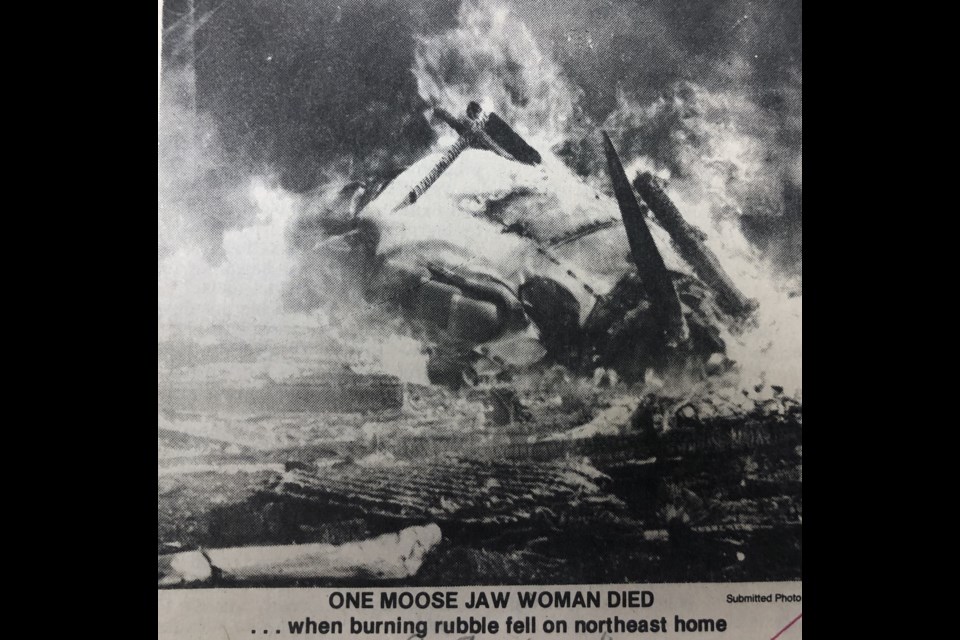Editor’s note: The information for this series came from the Moose Jaw Public Library archives, the Moose Jaw Museum and Art Gallery, and EphemeralTreasures.net.
The mid-air collision scattered bodies from the passenger plane over a wide area in northeast Moose Jaw, including the exhibition grounds, a golf course and nearby streets and fields.
In many cases, the bodies were badly mutilated, and death was likely instantaneous for some passengers on the Trans-Canada Airlines North Star plane travelling from Montreal to Vancouver. The pilot of the Harvard trainer also died after his plane plummeted to the ground.
Many citizens witnessed the collision, but many more heard the explosion as the North Star disintegrated, prompting hundreds in cars and thousands on foot to visit the scene, directed by a heavy pall of smoke rising high into the air.
“Pieces flew everywhere as (the North Star) struck the ground. One gas tank crashed into a house and set it afire. Two other houses were also set ablaze,” the Times-Herald reported in its afternoon edition of April 8, 1954.
City police, the RCMP, service police and railway police rushed to the scene, made difficult with most traffic lanes jammed. Meanwhile, firemen spent three hours battling the blaze that engulfed the Hume home and affected two adjacent homes; all 44 city firefighters worked that day.
Bodies and debris were strewn over the Willowdale Golf Club course, nearby streets, in the exhibition grounds — then between Ross School and the armouries — and the club’s parking lot.
One woman said a man hurtled onto her front lawn and “hit so hard, he bounced.” Meanwhile, workers at the golf course said they saw bodies “dropping like raindrops” from the big TCA liner.
As rescue personnel began recovering the bodies, they found that most were shoeless because the explosions had ripped off footwear and clothes, while clothes on some burn victims disintegrated like dust upon touch.
Personal effects were removed from bodies and deposited into bags bearing the same tagged number as the stretchers. Two truckloads of goods were collected while two police investigators and a stenographer attempted to inventory the items.
“Many of the articles, which consisted of clothing, shoes, hats, handbags and the like, are badly charred and identification is exceedingly difficult,” the Times-Herald said.
A pile of news magazines was found in the airliner, and on their covers, ironically enough, was a picture of a hydrogen bomb blast over the Pacific.
“To many in this quiet railway and farming town, Thursday’s explosion when the airliner hit the residential area sounded like a giant bomb going off,” the article said.
A brother identified his sister by looking at an inscription on the inside of her wedding ring, while stunned relatives converged on Moose Jaw — by plane and rail, from east and west — searching through the stretchers for loved ones.
Other witnesses also described what they saw.
Art Boisclair, a Canadian Pacific Railway trainman, responded to the scene after hearing the explosion and seeing pieces of the passenger plane explode everywhere. He ran to the crash site and found six bodies in a nearby backyard and 15 bodies on the railroad tracks and around the golf clubhouse. Other corpses were also badly burned.
“All the bodies were badly broken up. Some had lost legs, arms and heads. I then began picking up bodies and covering them with blankets,” Boisclair said.
“There weren’t enough stretchers or ambulances to take them away. We were finding bodies faster than the ambulance could pick them up.”
Two ambulances and three city dump trucks helped take the bodies to the armouries. Boisclair noted that some rescuers turned away when they picked up the bodies because of the gruesome sights, something he understood since few people did that for a living.
Boisclair and others also found a pile of smouldering, along with a fur coat, cameras, film, watches and suitcases.
“There was someone there giving out coffee and sandwiches. I ate only one. I wasn’t hungry after what I had seen!” he added. “It was a horrible sight.”
A.R. Lockhart, a real estate agent, had just stepped out of a house he was showing when “there was a report like a cannon overhead.” He looked up and saw the passenger plane with flames shooting out of its tail and missing a wing. It then slipped sideways and crashed into the Hume home.
“I stood almost petrified for a few seconds as it looked as though the large portion of the plane that remained after the explosion would land on the house I had just left,” he recalled.
After the fuselage hit the ground, there was a second tremendous explosion from which flames rose 75 to 100 feet into the air. Lockhart rushed to help remove furniture from Dr. Keith Yonge’s house adjacent to the Hume residence.
Mrs. Murray Brown, who lived on the other side of the Humes, said the first sound she heard was an explosion.
“There was a terrific and terrifying noise and I ran to the back door. Everything seemed to be on fire and there were bodies and pieces of wood flying in all directions,” she said.
“One body fell in our front yard. I’ll never forget the scene as long as I live.”




